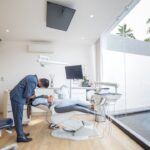Dental emergencies can be frightening and painful, but it’s important to understand what constitutes a dental emergency so that you can seek the appropriate care. A dental emergency is any situation that requires immediate attention from a dental professional to save a tooth, stop bleeding, or alleviate severe pain. This can include a knocked-out tooth, severe toothache, broken or cracked tooth, or injury to the soft tissues of the mouth. It’s important to recognize the signs of a dental emergency so that you can seek treatment as soon as possible to prevent further damage or complications.
In addition to physical trauma, dental emergencies can also be caused by untreated dental issues such as infections or abscesses. These can lead to severe pain, swelling, and even systemic health issues if left untreated. Understanding the signs and symptoms of a dental emergency can help you act quickly and seek the appropriate care to address the issue before it worsens. It’s important to remember that even if the pain subsides or the issue seems to improve, it’s still crucial to seek professional dental care to ensure that the underlying problem is properly addressed.
Key Takeaways
- Dental emergencies can include severe toothaches, broken or knocked-out teeth, and injuries to the mouth or jaw
- In a dental emergency, it’s important to stay calm, control bleeding, and seek immediate dental care
- Finding a dental emergency near you can be done by searching online, calling local dental offices, or asking for recommendations
- To prepare for a dental emergency, have a dental first aid kit, know your dentist’s emergency contact information, and understand your dental insurance coverage
- Common dental emergencies include toothaches, broken teeth, and knocked-out teeth, and they should be handled with care and urgency to prevent further damage
What to Do in a Dental Emergency
In the event of a dental emergency, it’s important to remain calm and take swift action to address the issue. If you experience a knocked-out tooth, it’s crucial to handle the tooth carefully by the crown (the part that is normally visible in the mouth) and avoid touching the root. Rinse the tooth gently with water if it’s dirty, but do not scrub or remove any attached tissue fragments. Try to reinsert the tooth into its socket, but if that’s not possible, place it in a container of milk or a tooth preservation product recommended by your dentist and seek immediate dental care.
For severe toothaches or injuries to the soft tissues of the mouth, it’s important to rinse the mouth with warm water and use dental floss to remove any trapped food or debris. You can apply a cold compress to the outside of the mouth or cheek to reduce swelling and alleviate pain. Over-the-counter pain medication can also be used to manage discomfort until you can see a dentist. It’s crucial to contact a dental professional as soon as possible in the event of a dental emergency to receive prompt and appropriate care.
Finding a Dental Emergency Near Me
When faced with a dental emergency, it’s important to find a dental professional who can provide immediate care. Many dental offices have emergency services or can accommodate urgent appointments for patients experiencing dental emergencies. You can start by contacting your regular dentist to see if they offer emergency care or can refer you to another provider who does. If it’s after hours or your regular dentist is unavailable, you can search online for “emergency dental care near me” to find nearby providers who can address your urgent dental needs.
It’s also helpful to have a list of emergency dental providers in your area before an emergency occurs so that you can act quickly and seek care without delay. You can ask friends, family, or coworkers for recommendations or search online for reviews and ratings of emergency dental providers in your area. Having this information readily available can help you make informed decisions and seek prompt care in the event of a dental emergency.
How to Prepare for a Dental Emergency
| Emergency Dental Care | Preparation Tips |
|---|---|
| Have a list of emergency dental contacts | Keep a list of local emergency dental clinics and contact information |
| First aid kit | Keep a first aid kit with dental supplies such as gauze, cotton balls, and temporary filling material |
| Know basic dental first aid | Learn how to handle common dental emergencies such as toothaches, broken teeth, and knocked-out teeth |
| Insurance information | Keep your dental insurance information easily accessible in case of an emergency |
While no one wants to experience a dental emergency, it’s important to be prepared in case one occurs. One way to prepare for a dental emergency is to have a dental first aid kit on hand at home and when traveling. This kit can include items such as gauze, a small container with a lid, over-the-counter pain medication, dental floss, and a cold compress. Having these items readily available can help you address minor dental issues and manage discomfort until you can see a dentist.
It’s also important to have the contact information for emergency dental providers saved in your phone or written down in a convenient location. This can include the phone numbers and addresses of nearby emergency dental offices or after-hours contact information for your regular dentist. Being prepared with this information can help you act quickly and seek care without delay in the event of a dental emergency.
Common Dental Emergencies and How to Handle Them
There are several common dental emergencies that may require immediate attention from a dental professional. One of the most common is a knocked-out tooth, which requires swift action to increase the chances of saving the tooth. If a tooth is knocked out, it’s important to handle it carefully by the crown, rinse it gently if dirty, and try to reinsert it into its socket. If that’s not possible, place it in milk or a tooth preservation product recommended by your dentist and seek immediate care.
Another common dental emergency is a severe toothache, which can be caused by various issues such as an abscess, infection, or injury. Rinsing the mouth with warm water, using dental floss to remove trapped debris, and applying a cold compress can help manage discomfort until you can see a dentist. Broken or cracked teeth are also common dental emergencies that require immediate attention. Rinse the mouth with warm water, apply a cold compress, and seek prompt care from a dental professional.
What to Expect at a Dental Emergency Appointment

When you seek care for a dental emergency, you can expect the dental professional to conduct a thorough examination of the affected area and possibly take X-rays to assess the extent of the issue. They will discuss your symptoms and medical history and may recommend treatment options such as root canal therapy, extraction, or restorative procedures to address the problem. The goal of a dental emergency appointment is to alleviate pain, prevent further damage, and save the affected tooth or teeth whenever possible.
Depending on the nature of the emergency, the dental professional may provide immediate treatment such as draining an abscess or stabilizing a broken tooth. They will also provide instructions for at-home care and follow-up appointments as needed. It’s important to follow their recommendations closely and attend any scheduled follow-up appointments to ensure that the issue is properly addressed and monitored.
Preventing Dental Emergencies
While some dental emergencies are unavoidable, there are steps you can take to reduce your risk of experiencing one. Maintaining good oral hygiene by brushing and flossing regularly can help prevent issues such as cavities and gum disease that can lead to dental emergencies. Wearing a mouthguard during sports activities can also protect your teeth from injury.
Regular visits to your dentist for check-ups and cleanings can help identify and address potential issues before they become emergencies. It’s also important to avoid chewing on hard objects such as ice or popcorn kernels and using teeth as tools to open packages, which can lead to broken or cracked teeth.
By taking these preventive measures and being prepared for potential emergencies, you can reduce your risk of experiencing a dental emergency and ensure that you’re ready to act quickly and seek appropriate care if one occurs.
If you are experiencing a dental emergency near me, it is important to seek immediate care. One helpful resource for finding a dental professional in your area is Natural Vital Spark. They offer a range of dental services and can help connect you with a qualified dentist who can address your emergency. For more information on dental emergencies and how to find the right care, check out their article on dental emergency care.
FAQs
What is a dental emergency?
A dental emergency is a situation that requires immediate attention from a dentist to alleviate severe pain, stop bleeding, or save a tooth.
What are some common dental emergencies?
Common dental emergencies include severe toothache, knocked-out tooth, broken or chipped tooth, abscess, lost filling or crown, and injury to the soft tissues of the mouth.
What should I do in a dental emergency?
In a dental emergency, it is important to contact a dentist as soon as possible. In the meantime, you can rinse your mouth with warm water, use dental floss to remove any food trapped between teeth, and apply a cold compress to reduce swelling.
How can I find a dental emergency near me?
You can find a dental emergency near you by searching online for emergency dental services or by contacting your regular dentist to see if they offer emergency appointments.
When should I go to the emergency room for a dental emergency?
You should go to the emergency room for a dental emergency if you are experiencing severe bleeding that does not stop, severe swelling that is affecting your breathing or swallowing, or if you have sustained a head or jaw injury along with dental trauma.


